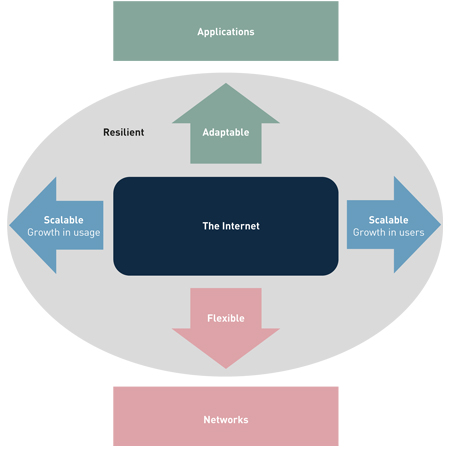Study on the Internet's technical success factors
08 December 2021 | Consulting
Amund Kvalbein | David Abecassis | Julia Allford | Michael Kende
Report
Analysys Mason was engaged by APNIC and LACNIC, the regional Internet registries for the Asia-Pacific and Latin America regions respectively, to investigate the technical success factors of the Internet. The results of this investigation are documented in a report first presented at the 2021 Internet Governance Forum.
A summary of the report is available here.
The global success of the Internet is often taken for granted today, based on almost any measurement – the number of users and the breadth of their geographical scope, and the level of usage and the depth of reliance on the Internet. This success has been built on protocols, standards, operational practices and communities developed over the past 50 years. Some of the foundations for this success were built into the Internet architecture from the beginning, while others have emerged as the Internet has evolved.
However, the success of the Internet should not be taken as given. Throughout the history of the Internet until the present day, questions have been raised about the future viability of the Internet. These questions often arise from an idealistic view of the Internet in the face of assorted threats or challenges and have led to proposed alternative network architectures and approaches. These may be motivated by genuine concerns about the suitability of the Internet or a particular protocol, by commercial, social or socioeconomic considerations, geopolitics, or a combination of these motivations. This report deliberately avoids assessing these motivations and is instead grounded in an objective analysis of the Internet as it exists today, based on highlighting technical success factors and taking a realistic approach to addressing challenges.
In this report, we argue that the technical success of the Internet is manifested through four dimensions of success. The Internet has successfully scaled to the increased demand from new users and usage, it has been flexible to new underlying network technologies, it has adapted to new applications, and the whole has been resilient to shocks and changes. We provide evidence of how the Internet is scalable, flexible, adaptable and resilient, and discuss the technical properties of the Internet that underlie these four dimensions of success. The four dimensions of success are illustrated in the figure below.

The early development of the Internet was based on openness, simplicity and decentralisation. The adoption of these three guiding ideals resulted from conscious decisions taken by the early Internet developers, and they have shaped the technical, organisational and operational development of the Internet. These ideals were not general practice at the time, and they represented a change from the design of the existing dominant network of the day, the telephone network.
Three well-known design principles that sprung out of the guiding ideals have been central to the Internet’s development and are useful concepts to understand the dimensions of success: these are the layering, network-of-networks and end-to-end principles. We explain how the variety of underlying network technologies that provide Internet access and carry traffic, the protocols that allow communication within and across the networks that constitute the Internet, the interconnection model that allows individual networks to form business relationships with other networks, the openness to new applications, and operational practices prevalent in service provider networks, have developed in light of these three design principles.
The main contribution of this report is to highlight the technical success of the Internet, by exploring the four dimensions of success we introduced above and relating them to the guiding ideals and the design principles. We show how key protocols, design principles, and operational practices have enabled the Internet to scale to its current size (and without obvious future constraint), how it has been flexible in the use of underlying network technologies, how the Internet has been able to adapt to the requirements of new applications, and how the Internet has shown resilience to attacks and sudden changes.
We also highlight that while we believe the design principles have been important to this success, they are not universal rules that are always abided by in practice. In fact, we argue that one key to the Internet’s success has been the ability to bend, or even break, its own technical principles when needed, without compromising the dimensions of success. The intrinsic resilience of the Internet has allowed its continual operation even in the face of these unanticipated compromises.
The Internet continually scales, adapts to new applications, and remains flexible to new network technologies. Towards the end of this report, we discuss potential challenges to the Internet model. These can come from perceived technical limitations that may prevent the Internet from offering (for instance) guaranteed security and performance, or they can come from the interests of governments or large Internet companies that are transforming the Internet, but not in ways that impact the dimensions of success. While there are proposals for fundamental changes to the Internet, we conclude that a continuation of the constant evolution of the Internet can address the potential challenges, while continuing to enjoy success across the identified dimensions.
Study on the internet's technical success factors
Download (PDF)Authors

Amund Kvalbein
Partner
David Abecassis
Partner, expert in strategy, regulation and policy
Julia Allford
Consultant
